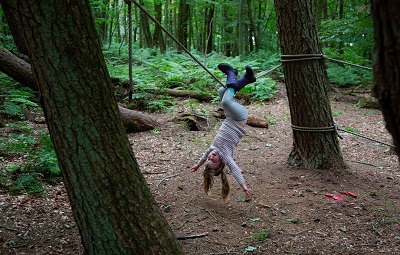
The Benefits of Risky Play
We have seen many children arrive at the Secret Garden, often having just celebrated their third birthday, and not only get to grips with our unique entry into the nursery day (waterproofs on, backpacks on, playpark interlude, then a half-mile hike up to the woods) but also with the unique terrain, and the risky play opportunities this provides.
Although everything exciting has some element of risk involved, denying children the right to discover what they are capable of is to deny them vital opportunities to develop and thrive on their own terms. By taking chances in their play, children learn valuable lifelong skills; how to risk-assess independently, how to support, communicate and negotiate with others, how to navigate the sometime-turbulent waters of getting mixed results…
Naturally, there are limits. The safety of both staff and children is taken very seriously, with risk assessments regularly updated for all of the locations we go to, and through. (Deliberately titled ‘Benefit Risk Assessments’ in acknowledgement that great gains can be made from giving activities with an element of risk a go.) Adults are aware, always watchful, nearby and on hand should they need to step in.
But in the main, the parameters are set by the child. Although physical dexterity, judgement and observation skills differ, children are naturally primed for survival and intrinsically aware of their own boundaries, capable of measuring risks and making sound judgements. Many children are skilled at self-regulation, with an instinctive sense of their own capabilities. It would be careless to overlook this and prevent them from shaping their individual approach to risk.
We also have a responsibility to respect and nurture the children’s natural curiosity, enabling and facilitating play that rewards them in the pursuit of it. This cannot exclude risky play, with levels available for all. For every tree that can offer a challenging climb six feet off the ground, (this, we feel, is a comfortable limit) there is a log that can provide a balancing opportunity of just a few inches.
We believe strongly in helping children to recognise and set their own limits when it comes to assessing and tackling risky play. For example, a child asking a grown up to lift them up into a tree or onto a swing is perhaps not quite ready for a challenge of that size. Which is perfectly fine. With a trusted adult closeby, holding the space for them, often we find this same child will be ready later that day. Or later that hour, or even after a few more minutes of considering, evaluating, emboldening…
Witnessing first-hand the obvious triumph and pride a child gains by ascending one branch higher, whizzing down a mudslide or landing deftly on top of a hay bale is like seeing a fire suddenly catch. The accomplishment is electrifying, and the child will often whoop, beaming, or run about as a sudden rush of joy powers through them.
Launching out into the wilderness is exciting. Testing oneself in the wilderness is exhilarating, and returning from the wilderness buoyant from the experience is life-affirming, building independence, confidence, and fanning the flames of self-belief.
